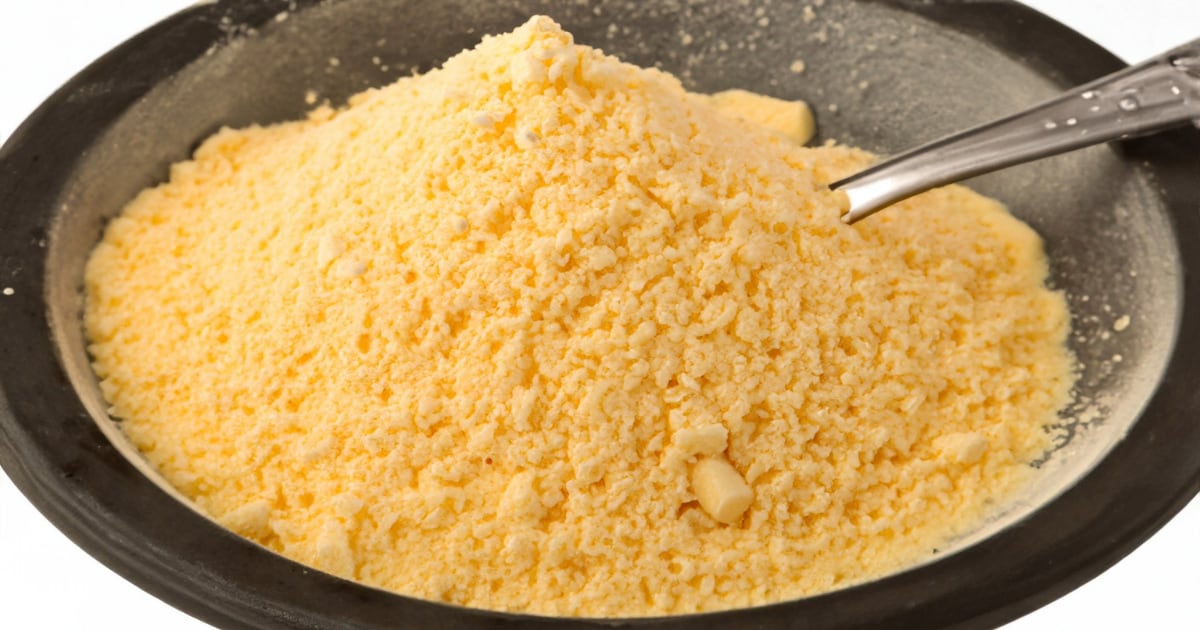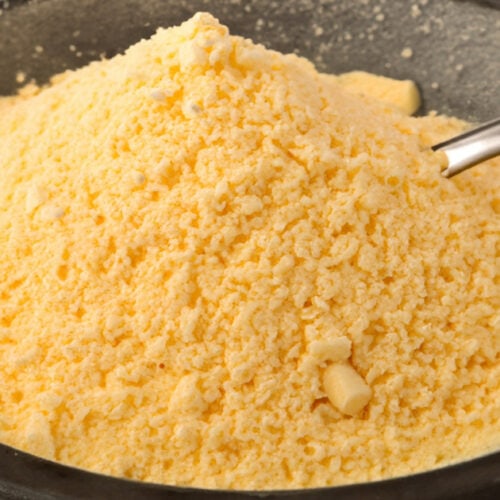Mac and cheese is a beloved comfort food for people of all ages. With its creamy, cheesy goodness, it's no wonder why it continues to be so popular. But making homemade mac and cheese from scratch can be time consuming with grating cheese, making a béchamel sauce, and carefully balancing seasonings.

That's why mac and cheese powder is a total game changer for making quick and easy stovetop macaroni and cheese. This powder mimics the taste of the nostalgic boxed stuff from your childhood, but allows you to control the ingredients. With just a few pantry staples, you'll have a steaming bowl of cheesy pasta in minutes.
Mac and cheese powder, often called cheese sauce powder, is a blend of ingredients that mimics the taste of melted cheese. It's used to quickly prepare a smooth and creamy cheese sauce to toss with cooked pasta.
The main ingredients in mac and cheese powder include:
- Dried cheddar cheese - This provides identifiable cheese flavor. Using real cheese is key to making the powder taste authentic.
- Starch - Corn starch or tapioca starch helps thicken the sauce and makes it wonderfully glossy.
- Spices and flavorings - Ingredients like garlic powder, onion powder, mustard powder, lemon pepper, and turmeric replicate the tangy zip and vibrant color of cheddar cheese sauce without artificial colors.
- Non-dairy milk powder - Powdered milk helps make the sauce rich, creamy, and substantial.
When whisked into hot liquid like milk or a non-dairy alternative, the powder quickly dissolves into a luxuriously smooth, pourable cheese sauce. It clings perfectly to pasta with a satisfyingly stretchy texture.
Key Takeaway: Mac and cheese powder is a mixture of dried cheese, starch, and seasoning that makes an instant cheese sauce.
Why Use Mac and Cheese Powder?
There are so many reasons to keep mac and cheese powder on hand:
It's fast - With mac and cheese powder, dinner comes together in the time it takes to boil water and cook the pasta. No lengthy prep or simmering required.
Super convenient - Because it's dry and shelf-stable, you can stash a batch in your pantry for whenever a mac craving strikes. Whip up one serving or enough for a crowd.
Customizable - Make it as cheesy as you want by adjusting the amount of powder you add. Sprinkle extra on top too.
Endlessly versatile - Use the sauce for more than just pasta. Try it on steamed broccoli, cauliflower, or potatoes. Dip anything in it!
Kid-friendly - Kids of all ages love mac and cheese. Having an instant version makes it easy to please picky eaters.
Travel-ready - Bring single-serving pouches of the powder on trips for an easy hotel room dinner.
How To Make Mac and Cheese Powder

Mac and Cheese Powder Recipe
Ingredients
Instructions
Steps:
- Add all ingredients to a blender, food processor, or spice grinder. Process until a fine powder forms.
- Transfer powder to an airtight container and store in a cool, dark place for up to 6 months.
- To use, follow the mac and cheese recipe below.
To make mac and cheese:
- 1 cup dry macaroni pasta
- 3⁄4 cup milk or non-dairy milk
- 2 tablespoons butter or vegan butter
- 1⁄4 cup mac and cheese powder
Steps:
- Cook pasta according to package directions until al dente. Drain and return to pot.
- Warm milk in microwave or small saucepan until hot but not boiling.
- Whisk mac and cheese powder into hot milk until smooth.
- Pour cheese sauce over cooked pasta and stir well to coat.
- Stir in butter until melted. Add more powder for extra cheesiness if desired.
- Serve mac and cheese immediately for best texture.
Notes
- For ultimate creaminess, add powdered cheese to room temperature milk and let sit 5 minutes before heating. The starch will start thickening the milk.
- Try using evaporated milk or half and half instead of regular milk for even richer flavor.
- Mix flavors by adding a little French onion soup mix or ranch seasoning into the powder.
- Make it spicy with cayenne and paprika or smoky with chipotle chile powder.
- Toss in cooked veggies like broccoli florets or peas just before serving.
DIY Flavored Mac and Cheese Powders
Plain cheddar mac and cheese powder makes a wonderful base sauce. But why stop there when you can create all kinds of exciting flavors?
Use the basic powder recipe above and add your own custom blend of spices and ingredients. Here are some ideas to get you started:
Nacho Cheese Powder
Great on taco pasta or nachos.
- 1 tablespoon chili powder
- 2 teaspoons cumin
- 1 teaspoon garlic powder
- 1⁄2 teaspoon cayenne pepper
Ranch Cheese Powder
Tastes awesome on baked potatoes too.
- 1 packet ranch dressing mix
- 1 tablespoon dried parsley
- 1 teaspoon garlic powder
- 1 teaspoon onion powder
Pizza Cheese Powder
Pizza night just got easier.
- 1 tablespoon Italian seasoning
- 1 teaspoon dried basil
- 1⁄2 teaspoon dried oregano
- 1⁄2 teaspoon garlic powder
Beer Cheese Powder
For grown-up mac and cheese.
- 2 tablespoons beer powder
- 1 tablespoon mustard powder
- 1 teaspoon onion powder
- 1 teaspoon paprika
Chipotle Cheese Powder
Smoky spice and everything nice.
- 1 tablespoon chipotle chile powder
- 1 teaspoon cumin
- 1 teaspoon oregano
- 1⁄2 teaspoon garlic powder
Get creative with flavors that you enjoy. The possibilities are endless for customizing homemade mac and cheese powder.
Can You Make Dairy-Free Mac and Cheese Powder?
If you want to make a completely dairy-free mac and cheese powder, you certainly can. It just requires switching up some of the ingredients.
To make 1 cup of dairy-free powder:
- 3⁄4 cup nutritional yeast
- 1⁄2 cup arrowroot starch or all-purpose gluten-free flour
- 1 tablespoon vegan butter or refined coconut oil
- 1 tablespoon white sugar
- 2 teaspoons onion powder
- 1 teaspoon garlic powder
- 1 teaspoon lemon pepper
- 1 teaspoon mustard powder
- 1⁄2 teaspoon turmeric
Follow the same method of combining everything in a blender or food processor until powdered.
When making your mac and cheese, use unsweetened non-dairy milk like almond, soy, oat, or coconut. Add some vegan butter like Earth Balance.
The sauce likely won't be quite as thick using starch instead of dairy powder. But it will still have that delicious, craveable flavor. Enjoy your dairy-free mac with confidence!
Can Mac and Cheese Powder Be Used In Other Dishes?
You bet! Mac and cheese powder is a wonderfully convenient way to infuse cheesy flavor into all kinds of dishes beyond basic pasta and cheese.
Because the powder contains real cheese, thickening starch, and savory seasoning, it makes an easy shortcut sauce, coating, or topping.
Here are some tasty ways to use it:
- Make cheese popcorn by shaking the powder with popcorn kernels and oil before popping.
- Use it to bread and fry tofu, chicken, or fish cutlets for cheesy panko crust.
- Mix into rice pilaf or risotto for creamy texture and flavor.
- Make loaded baked potatoes by sprinkling powder on top along with bacon bits.
- Stir into scrambled eggs or omelets just before serving to make breakfast cheesier.
- Sprinkle on tacos, nachos, enchiladas, empanadas, or tamales.
- Mix with canned soup or stew to infuse everything with cheesy richness.
- Make veggie dip by blending powder into Greek yogurt or mayo.
The possibilities are endless when you have an instant powder that can make anything taste like it's covered in melted cheese!
Key Takeaway: Get creative using mac and cheese powder to add cheesy goodness to soups, veggies, grains, sandwiches, snacks, and more for an instant flavor boost.
Homemade Mac and Cheese Powder Tips
Making your own mac and cheese powder at home means you control the ingredients. But there can still be minor issues that come up:
Powder seems grainy or clumpy - Make sure to thoroughly blend or process the powder to break down any lumps. Sift it after blending if needed.
Sauce too thin - The starch needs sufficient time heating in liquid to activate and thicken. Cook sauce 2-5 minutes, stirring constantly.
Flavor seems flat - Up the amount of powder used, add a pinch or two more salt, try using evaporated milk for richness, or stir in extra butter at the end.
Texture is gluey or gummy - Don't overcook the sauce once thickened. Remove from heat promptly and add pasta right away to absorb excess moisture.
Color is dull or grayish - Turmeric and paprika provide vibrancy to the powder. Make sure both are fresh for the best color payoff.
Tweaking a recipe is part of the fun with homemade mixes. Keep notes about any adjustments you make each batch to perfect your own signature creation.
Storing Mac and Cheese Powder
One of the best things about DIY mac and cheese powder is that it keeps for months stored properly. Be sure to:
- Store powder in an airtight container - Mason jars or food storage containers with a tight seal work perfectly.
- Keep container in a cool, dark place - The fridge is ideal, but any indoor cabinet away from heat and light ensures longest shelf life up to 6 months.
- No need to refrigerate once opened - The low moisture content prevents spoilage at room temp.
- Use clean, dry utensils when scooping out powder - Leftover pasta sauce or butter can cause clumping.
- Give it a stir or shake before using - Ingredients may compact a bit but redistributing prevents any lumps.
With just a few basic precautions, your homemade mac and cheese powder will stay fresh for months to come. No more wondering what to do with that partially used block of cheddar cheese.
FAQs
Is boxed mac and cheese powder the same?
Commercial powder tends to use ingredients like whey protein concentrate and artificial coloring to lower costs. Making your own allows you to control quality.
Can I use a food processor or blender?
Yes, you need some way to break down nutritional yeast flakes and thoroughly combine dry ingredients into a fine powder. Use what appliance you have available.
Is mac and cheese powder really shelf stable?
Properly stored in an airtight container away from direct light and heat, the powder lasts 6 months or longer without refrigeration.
Do I have to use elbow macaroni pasta?
Nope! The creamy cheese sauce powder makes clings to any shape pasta beautifully. Try fun ones like shells, cavatappi, orecchiette, or rotini.
Can I use any type of milk?
Whole milk or 2% milk offer the creamiest, richest flavor. Non-dairy milk works well too as long as it's unsweetened. Evaporated milk makes it extra decadent.
What if I'm out of butter?
Omitting butter won't ruin the dish, but does affect creaminess and flavor. Substitute olive or vegetable oil instead of eliminating it entirely. Use 1-2 tablespoons.
Conclusion
From its wonderfully convenience to full customization potential, homemade mac and cheese powder truly elevates this popular comfort dish. Keeping a batch mixed up in your pantry means cheesy pasta cravings can be satisfied anytime with little effort.
Get creative swapping out flavors or using it as an instant flavor-boosting topping for soups, grains, veggies, and more.

